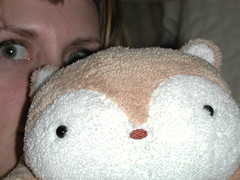March 11, 2006
Peace museums, simulation, and interactivity
Ayme Frye posted recently about the Navy Underground Tunnels on Okinawa, including a recording she took while in the tunnels. Walking around the tunnels and even outside you couldn’t escape the mindless looped flute music and narration piped through speakers everywhere.
For me, the presentation of the underground tunnels showed a desire to mask or forget the realities of the tragedy. From the soothing music (it sounded like inane versions of martial music actually), to the cheery, polite voice; from the souvenirs assaulting you immediately after you exit, to the euphemistic brochure—it all seemed to be an attempt to distract from the gravity of the place. Almost like a way to distract so one wouldn’t suffer the embarassment of being emotionally touched. All it lacked was a kawaii mascot.
I’m not sure if you could relegate this to the realm of “cultural difference,” as the trip to the Okinawa Prefectural Peace Museum later that day attested to the possibilities of a very powerful and emotional representation of war tragedy. Also contrasted with the Hiroshima Peace Museum, another highly sophisticated museum, I would dare to say that the presentation of the Navy Underground Tunnels has more to do with funding and poor design than any sort of cultural difference. Unless you take the view that the other Peace Museums, because they are more international in scope, take on a more international and less Japanese method of presentation, with multi-media displays, etc. But I would venture to say that the Underground Tunnels was merely a poor imitation of these more sophisticated museums, trying to integrate some level of multi-media with its audio presentation. What they forgot was that the other museums were built from the ground up, so to speak, and need to use these multi-media presentations in order to simulate the effects of war. What they forgot was the inherent power of the tunnels themselves, and by trying to integrate the multi-media aspect they actually succeeded in detracting from the immediacy of them. I found the whole experience to be incredibly alienating.
To go back once again to Nadine Wasserman; at the end of her essay she talks about culture and marketing in the 21st century:
The real and the simulacra are interchangeable. Visitors can see “masterpieces” at the Bellagio Hotel in Las Vegas—the land of simulation—just as easily as they can at the Met. Cultural tourism can lead to Disney’s Epcot or Nike Town just as easily as to a “real” museum; and museums are borrowing tactics from shopping malls and from Disney to learn more about interactivity and visitor services.
This is incredibly apparent when walking through the Peace Museums. The appeal to the senses is so strong, especially at the Okinawa Museum with its nearly life-size recreation of the caves in which Okinawans sought refuge (complete with chilling wind simulation) and the post-war Okinawa street. They pulled out all the stops, practically transporting the viewer back in time.
I have visited many museums documenting the tragedies of war, but those built on actual sites don’t need to rely on Disney methods of interactivity and simulation. The chill is already in the air and the silence is so powerful.

